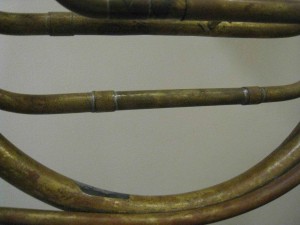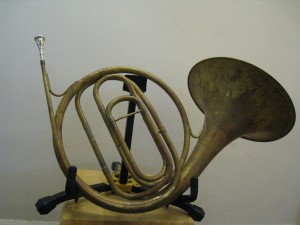By Joel Thurtell
I underwent my valvectomy some years ago.
The operation went very well.
I was on my feet throughout, though there was a point during the procedure when my wind pipe was cut off.
But once we spliced a new tube into place and soldered the whole thing together, we were pretty much home free.
I have no trouble blowing the open notes, and only my hand action limits my ability to hit the stopped notes.
Okay, I was not the one who had the surgery. The victim was an old, student-level, single F-pitch French horn. Not the kind of instrument anyone would go to bat for on hearing we planned to lop off all three of its valves.
I was not the surgeon. I assisted in the operating room, which was the basement workshop of my friend, Willard Zirk, music professor at Eastern Michigan University.
I’d wanted to have this operation ever since I heard the late Phillip Farkas, onetime dean of symphonic French horn players, demonstrate how to play a scale on a French horn without touching the keys that operate the valves.
I had not known that this was possible. I played horn in our Lowell High School band. I graduated from a single F horn to a double horn, capable of playing in the key of F or switching — by means of a thumb key-operated valve — to the key of B-flat. Shifting to B-flat makes it easier to hit high notes.
Farkas played a complete scale, C-D-E-F-G-A-B-C without touching the keys. The notes C-E-G and again C are easy enough, being so-called “open” notes that don’t require depressing a key to make their sound. He made the notes D-F-A-B by changing the position of his right hand in the bell of the horn.
Wow!
He proceeded to point out that until well into the 19th-century, musicians played on “natural” horns. They weren’t called natural horns then, because in the days of Bach through Beethoven, including Haydn, Mozart and the whole constellation of classical composers, the horn without valves was, well, the horn.

My 1963 Alexander double French horn is normally pitched in F and played with the three main keys. To hit high notes easier, I shift to B-flat with the thumb valve. To make the valvectomy, we cut the three-valve bridge out of an old single F-horn and replaced it with a straight piece of pipe. Photo by Joel Thurtell.
How I took up horn-playing after many years of not blowing a note is another story. But in the early 1990s, I was practicing horn, taking lessons and even played in a couple recitals. My horn was a Mirafone double F/B-flat instrument, decent enough, but always I struggled to hit high notes on the Mirafone. On the Mirafone, I tried Farkas’s stunt. I could do it, after a fashion. You just have to figure out how deeply to push your right hand into the bell to get a D, say, or an F, that is halfway between the adjacent open notes. Not so hard when fooling around, but try to do it playing a piece of decent music. Whew!
If you want to hear what the French horn sounded like in the time of Mozart and Beethoven, listen to Lowell Greer’s recordings and compare the sound to, say, Dennis Brain’s performances of the Mozart horn concertos or the Beethoven Sonata for Horn and Piano.
Brain was playing a valve horn. Greer plays a valveless horn.
If you listen carefully, you can hear the muffled sound of Greer’s stopped notes.
Well, anyway, I wasn’t satisfied just playing my valve horn without using the keys. I wanted a natural horn. One without valves.
What I got was my valvectomy.
It is not a true natural horn. That is, it is not the horn then world-famous horn player Johann Stich, aka Punto, played when he and his pal Ludwig van Beethoven sat down to play that wonderful Sonata for Horn and Piano composed by Beethoven in 1803.
My valvectomy may be kind of a fake, but it sure is fun to play. I’m not very good at it.
Truth to tell, I just recently started playing again, after several years of letting the horns sit in their cases.
I sold the Mirafone and bought a 1963 Alexander double F/B-flat horn. It is a marvelous horn.
But I still like to mess around with my cheap valvectomy.
How did we create the valvectomy?

Valvectomized French horn with original valves replaced with a bridge pipe. Photo by Joel Thurtell..
Willard had done it before. You hack-saw the two brass pipes that connect to the three valves. The valves are set in line, and once they’ve been removed, you bridge the gap with a piece of brass tubing, making solder connections where the valves were removed.
Now you have an ersatz natural horn that will play all the notes you want to play. This means that you have to work on your ear, because unlike a valve horn, the natural horn does not play stopped notes at pre-defined intervals. With the valve horn, all notes sound like open notes on a natural horn, even if they would e stopped notes on the natural horn. You get more clarity with a valve horn, but if for some reason you want to play your stopped notes a bit flat or sharp, you can arrange that by adjusting placement of your right hand in the bell.
As I get back into practicing horn, I find that I like to start playing on my valvectomy. It’s light and the air seems to move through it without effort. That is not my imagination. There is far less plumbing for the air to move through.
After playing a few C scales on the hand horn, I proceed to my Alexander. By now, my lip is limber and I can finish my practice session with my valve horn.
My valvectomy has a dull, earthy color. It looks quite rustic, like an old hunting horn.
So here’s my pitch: Do you have an old French horn you want to get rid of?
Please think of me — I’ll perform my little surgery and turn it into a valvectomy.
Drop me a line at joelthurtell@gmail.com
